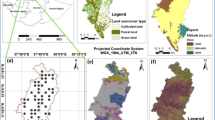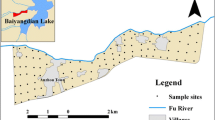Abstract
Unlike the situation for arable soils, virtually nothing is known about the spatial dependencies of soil properties in cool temperate grassland or about what the optimal sampling strategies ought to be for mapping soil nutrient distributions in such situations. The aim of this study was to investigate the spatial variability in ‘plant-available’ (soil) phosphorus and potassium in a grass silage field in Northern Ireland and devise ‘optimal’ sampling strategies for mapping their distributions. Soil samples were collected from the field at 25 m intervals in a regular rectangular grid to provide a database of soil properties. Different data combinations were subsequently abstracted from this database for comparison purposes, and ordinary kriging used to produce interpolated soil maps. Soil potassium displayed greater spatial variability than soil phosphorus. In keeping with this observation, the results of three separate statistical procedures demonstrated that the optimal sample size for estimating the ‘true’ population means was about twice as large for soil potassium as for soil phosphorus. Optimal sampling strategies, however, related not just to sample size but to sample combination and field shape as well.
Similar content being viewed by others
References
F. P. Agterberg, Trend surface analysis. In: Spatial Statistics and Models, edited by G. L. Gaile and C. J. Willmott (Reidel, Dordrecht, The Netherlands, 1984), p. 147.
P. M. R. Dampney, M. A. Froment, and C. J. Dawson, The variability of pH and available phosphorus, potassium and magnesium in soils within arable fields in England. In: Precision Agriculture '97, Proceedings of the 1st European Conference on Precision Agriculture, Volume 1: Spatial Variability in Soil and Crop, edited by J. V. Stafford (BIOS Scientific Publishers, Oxford, UK, 1997), p. 79.
Z. L. Frogbrook, The effect of sampling intensity on the reliability of predictions and maps of soil properties. In: Precision Agriculture '99, Proceedings of the 2nd European Conference on Precision Agriculture, edited by J. V. Stafford (Sheffield Academic Press, Sheffield, UK, 1999), p. 71.
M. A. F roment, A. G. Chalmers, S. Peel, and C. J. Dawson, The use of grid soil sampling to measure soil nutrient variation within intensively managed grass fields in the UK. In: Proceedings of the 3rd International Conference on Precision Agriculture, edited by P. C. Robert, R. H. Rust, and W. E. Larson (ASA/CSSA/SSSA, Madison, WI, USA, 1996), p. 227.
C. A. Gotway, R. B. Ferguson, G. W. Hergert, and T. A. Peterson, Comparison of kriging and inverse distance methods for mapping soil parameters. Soil Science Society of America Journal 60, 1237 (1996).
R. K. Gupta, S. Mostaghimi, P. W. Mcclellan, M. M Alley, and D. E. Brann, Spatial variability and sampling strategies for NO3-N, P and K determinations for site-specific farming. Transactions of the American Society of Agricultural Engineers 40, 337 (1997).
A. Hald, Statistical Theory with Engineering Applications (Wiley, New York, USA, 1960)
W. A. Jury, Spatial variability of soil properties. In: Vadose Zone Modeling of Organic Pollutants, edited by S. C. Hern and S. M. Melanion (Lewis Publishers, Inc., Chelsea, Michigan, USA, 1989), p. 245.
R. J. Lascano and J. L. Hatfield, Spatial variability of evaporation along with two transects of a bare soil. Soil Science Society of America Journal 56, 341 (1992).
A. B. McBratney and M. J. Pringle, Spatial variability in soil—implications for precision agriculture. In: Precision Agriculture '97, Proceedings of the 1st European Conference on Precision Agriculture, Volume 1: Spatial Variability in Soil and Crop, edited by J. V. Stafford (BIOS Scientific Publishers, Oxford, UK, 1997), p. 3.
A. B. McBratney and R. Webster, Choosing functions for semivariograms of soil properties and fitting them to sampling estimates. Journal of Soil Science 37, 617 (1986).
Ministry of Agriculture, Fisheries and Food, The Analysis of Agricultural Materials, MAFF/ADAS Reference Book 427 (HMSO, London, UK, 1986).
M. A. Oliver and Z. L. Frogbrook, Sampling to estimate soil nutrients for precision agriculture. In: Proceedings of the International Fertiliser Society, No. 417 (1998).
L. Sachs, Applied statistics (Springer-Verlag, New York, USA, 1982).
R. R. Sokal and F. J. Rohlf, Biometry, 2nd Edition (W. H. Freeman and Co, New York, USA, 1981).
T. Tsegaye and R. L. Hill, Intensive tillage effects on spatial variability of soil test, plant growth, and nutrient uptake measurements. Soil Science 163, (1998).
E. A. Yfantis, G. T. Flatman, and J. V. Behar, Efficiency of kriging estimation for square, triangular and hexagonal grids. Mathematical Geology 19, 183 (1987).
Author information
Authors and Affiliations
Rights and permissions
About this article
Cite this article
Shi, Z., Wang, K., Bailey, J.S. et al. Sampling Strategies for Mapping Soil Phosphorus and Soil Potassium Distributions in Cool Temperate Grassland. Precision Agriculture 2, 347–357 (2000). https://doi.org/10.1023/A:1012399915193
Issue Date:
DOI: https://doi.org/10.1023/A:1012399915193




